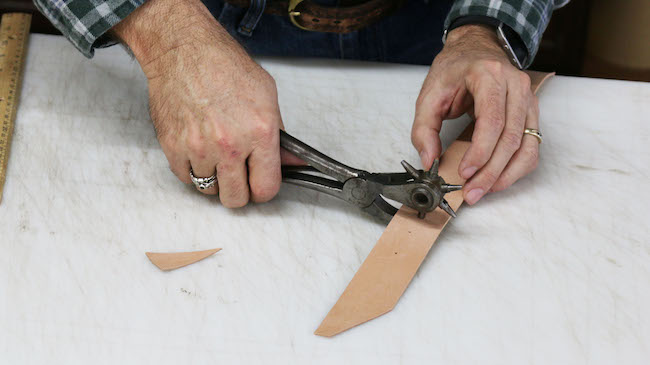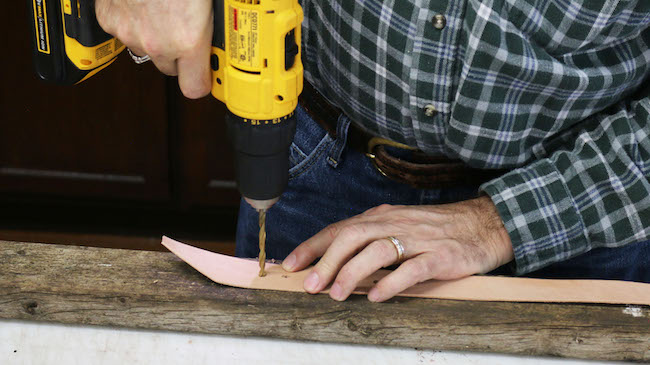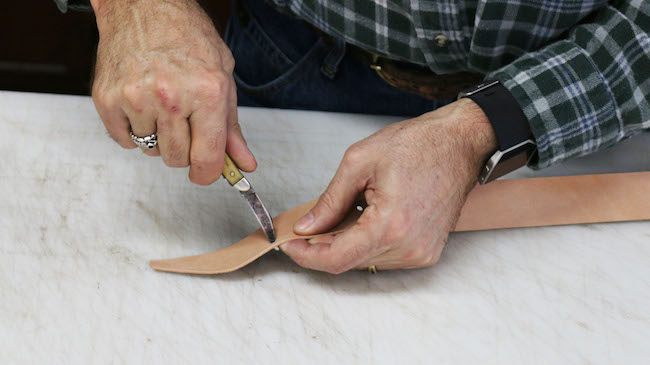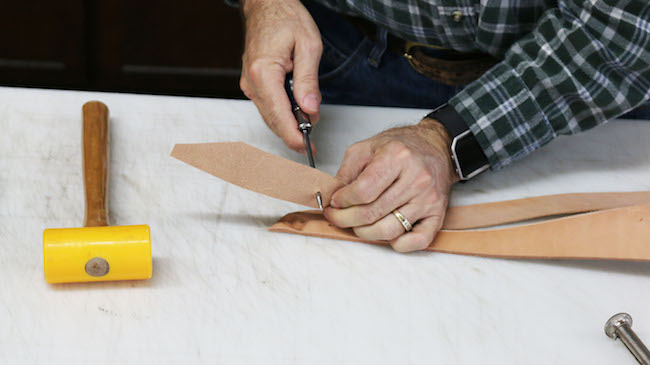
Editor’s Note: This is a guest article by Michael Magnus.
Whether putting on a few pounds at the holidays or getting fit and shedding inches with The Strenuous Life, it’s handy to know how to add a new notch or two to your leather belt. In this article, you’ll see several different methods for punching holes: some involve tools that make the job especially easy, while others allow you to make do with what you have.
The first 3 methods featured here will show ways to get an ideally rounded belt hole with minimal fuss. Following that, there are 3 techniques that require a bit more finessing, but can readily be used in a pinch.
Between these 6 methods, there’s bound to be one that matches the tools you personally have on hand.
Measuring the Holes

Regardless of which method of hole-making you choose, you’ll first want to measure out and mark where you want the hole to go.
The standard measurement between belt holes is 1 inch, center to center. Use a ruler or measuring device to mark the location of the new hole with either a pen or a Sharpie. Typically it does not matter which side of the belt you mark on since the plan is to remove that piece of leather.
Adding Rounded Holes to Your Belt
Although there are a number of different ways to perforate leather, simply puncturing it may result in the hole tearing during use.
It is important to round out the interior edges of the hole you make so that you are left with a circle large enough for the tongue of your belt buckle. This circular shape can help prevent tearing, providing strength to the belt when under stress from frequent use.
The following methods will, in just one step, result in a strong, nicely rounded hole.
The Rotary Punch

The rotary punch is perhaps the simplest and most straightforward solution. Tandy Leather makes some rotary punches that are specifically for leather; however, you may be able to find something workable at a regular hardware store. With this tool, typically you’ll want to use the #5 sized punch (usually the second from largest size); however, you may need something bigger or smaller depending on the buckle.
To use the rotary punch, first find the appropriately sized punch tube, rotate it into place, position it centered over your marking, and then squeeze the handle. Pretty straightforward and perhaps worth investing in this tool if you think you’ll be punching holes often.
The Round Drive Punch

This is another tool that if you don’t already have, can be purchased at Tandy or perhaps a hardware store. These sharp steel tubes come in several sizes, but typically you’d want to use the 3/16” size to make holes on a belt for a standard belt buckle.
Center the punch over the marking, give it a few solid whacks with a mallet, and you should be left with a perfectly round hole.
The Power Drill

The power drill is a tool you likely already have on hand. By using the 3/16” bit, you can carefully drill a hole into the leather. While this seems pretty straightforward, there’s still a little precaution to take here.
Make sure that you hold the belt down firmly when drilling holes into the leather; otherwise, the belt may catch the drill bit and spin in place. This can result in ruining the belt, and also some fairly impressive bruises.
Additionally, when drilling the hole, make sure that you have a piece of spare wood or something similar underneath. When the bit goes through the leather, it will continue on through whatever surface is beneath it, which may ruin the surface, the drill bit, or both.
Puncturing Holes Into Your Belt
When you have the option, one of the above methods is really your best bet. However, if you’re in a pinch, the following 3 methods can work as well.
As mentioned above, when simply puncturing a rough hole into a belt, it is more likely to tear. With any of the below methods, it is recommended that after you make the initial perforation, you then perform this second step: insert a small, sharp pocket knife into the puncture and twist it around in a circular motion to bore out some of the leather, rounding out and strengthening the hole.
The Pocket Knife

As just mentioned, a knife is going to come in handy for finishing out the hole on all 3 of these puncturing options, but you’ll have to be careful if using it to start one. When you use a knife to pierce the leather at your designated mark, the shape of the blade may make it difficult to puncture the leather without making a cut that is too large.
A small, sharp pocket knife is going to work better for this than a larger blade, but ultimately you have to use what you have. After carefully piercing the leather, slowly move the knife back and forth in a circular motion within the hole, effectively scraping out small amounts of leather until it reaches the appropriate size. This may take a little while. However, patience is key to not making the hole too large and achieving a rounded shape to help prevent tearing.
The Scratch Awl

If you have access to a scratch awl, a sewing awl, or even an ice pick, these can come in handy for getting the hole started and maintaining the right size. Typically, you can force any of these awls through the leather by hand; however, if the leather is thick or quite tough, you can give it a few taps with a mallet to force it through.
Once you’ve made the initial hole, you’ll have a good starting point for whittling out some leather with your pocket knife to create the appropriately sized, rounded hole.
The Nail

Another method for puncturing the leather to get the hole started is using a hammer and nail. Simply align the nail over your marking, drive it through with a hammer, and you’ve got your hole started.
It’s worth noting here that you probably want to have a piece of spare wood under the belt so that you have something for the nail to drive into. Also, don’t get overzealous with your hammering; otherwise, it might be challenging taking the nail out again.
After you’ve created the initial puncture with the nail, again, you’ll want to use a small, sharp pocket knife to round out the hole to prevent tearing.
_______________________________
Michael Magnus is a digital advertising lecturer, consultant, and freelancer based in North Texas. When not teaching or with his family, Magnus promotes the art of leatherworking as a recreational leathercraft historian and content creator with Elktracks Studio.







